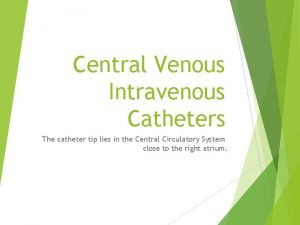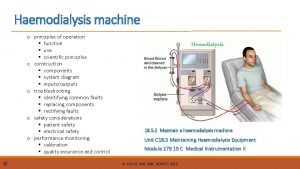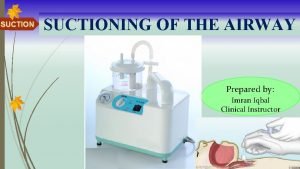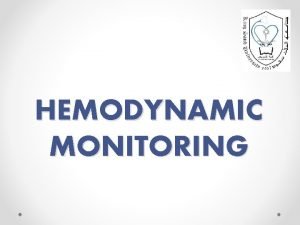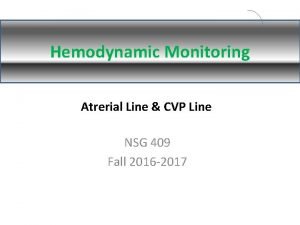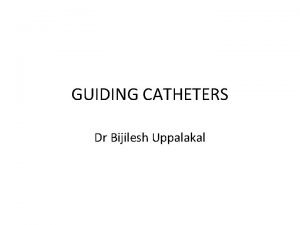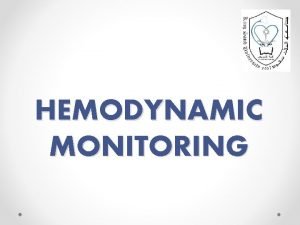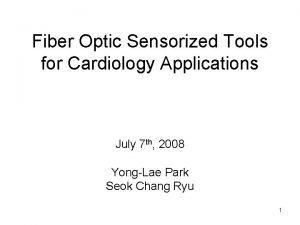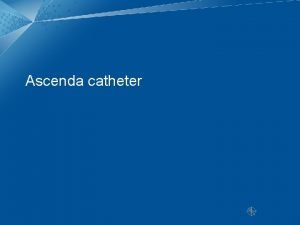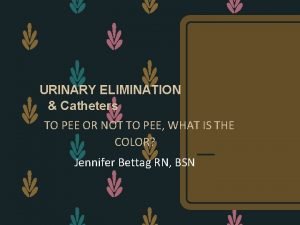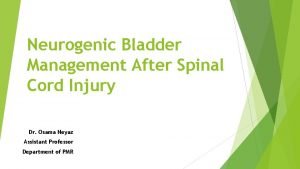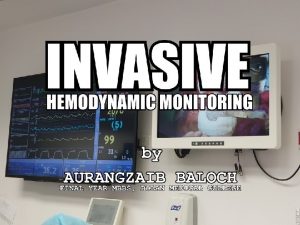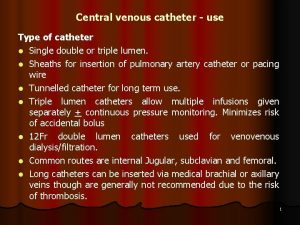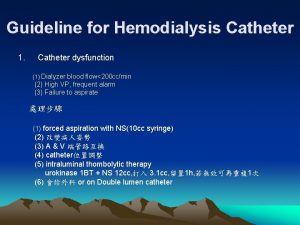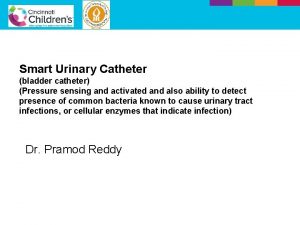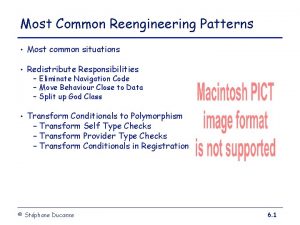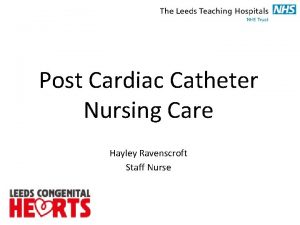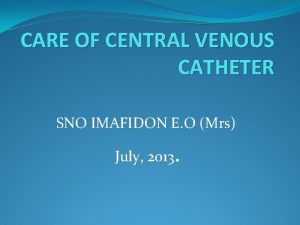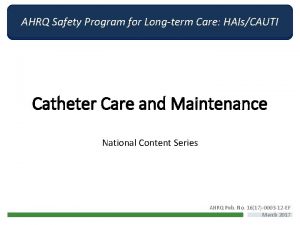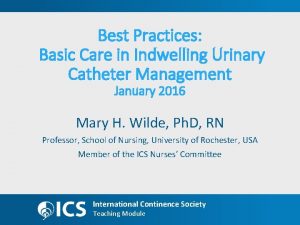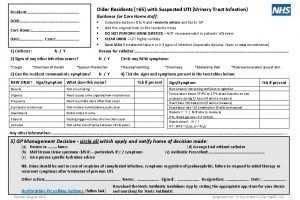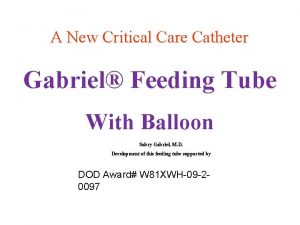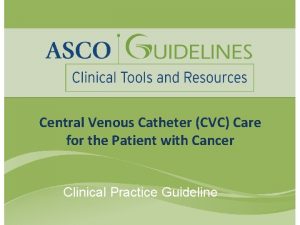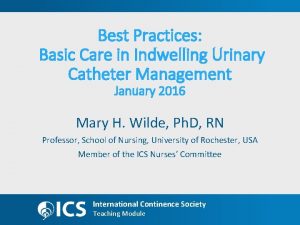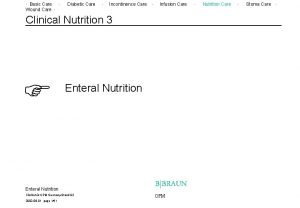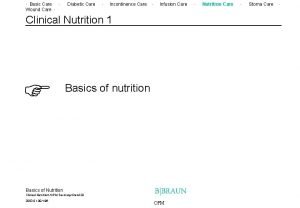Catheter Care in Haemodialysis Haemodialysis q Most common




























- Slides: 28

Catheter Care in Haemodialysis

Haemodialysis q. Most common method used to treat advanced & permanent kidney failure. q. Process to purify the blood of a person whose kidneys are not working normally. q. Achieves extracorporeal removal of waste products such as creatinine, urea & free water from the blood.

Dialysis Catheter and its Need q. For dialysis to work there must be a way of taking blood from the body, pumping it into the kidney machine & then back to the bloodstream. q. A dialysis catheter (sometimes called a “line”) is one way of doing this and it can be used more or less straight away.

Types of Dialysis Catheter In a patient receiving haemodialysis, the access is one of the following: q. An AV fistula made by joining an artery and vein in your arm q. An AV graft made by using a soft tube to join an artery and vein in your arm q. A catheter, a soft tube that is placed in a large vein, usually in your neck

Risks Associated with Poor Cannulation & Improper Care of Fistula Access survival depends on quality of needle puncture. q. Error in sticking of needles can shorten survival of the access & the patient. q. Loss of the fistula q. Further hospitalization q. Creation of temporary access measures q. Inconvenience q. Disrupt of regular treatment regimen q. Higher treatment costs

Check AVF & AVG q. Thrill: is a bussing pulsation or rushing sensation you feel it when you check for the blood flow along the access q. Bruit: is the whooshing noise you here it by the stethoscope along the access

Physical Assessment q. Assess AVF before every cannulation q. Compare arms for changes in skin colour, circulation, integrity q. Inspect v. Access extremity for central or outflow vein stenosis v. Distal areas of extremity for steal syndrome v. Access for vessel size, cannulation areas , infection and aneurysms q. Plapate v. Temperature change may mean infection or stenosis v. Change in thrill may mean stenosis q. Auscultate v. Listen to entire access for changes in bruit that indicate stenosis

Specific Infection Control Precautions q. Wear gloves and other personal protective equipment (PPE) for all patient care q. Promote vascular access safety q. Separate clean areas from contaminated areas q. Use medication vials safely q. Clean and disinfect the dialysis station between patients q. Perform safe handling of dialyzers

Wear Gloves During Patient Care q. Wear disposable gloves when caring for the patient or touching equipment at the dialysis station q. Wear gloves when cleaning surfaces in the environment or medical equipment q. Remember to remove gloves and perform hand hygiene between each patient or station, and if moving from a contaminated to clean area of the same patient or within the same dialysis station

Use Personal Protective Equipment (PPE) q. In addition to gloves, you should wear gowns & face protection to protect yourself as needed: ◦ During initiation and termination of dialysis ◦ When cleaning dialyzers ◦ When handling lab samples q. PPE should be changed if it becomes dirty

Basic Steps in Fistula/Graft Care Cannulation Procedure: 1. Wash the site 2. Perform hand hygiene 3. Put on a new, clean pair of gloves 4. Wear proper face protection 5. Apply skin antiseptic and allow it to dry 6. Insert needle using aseptic technique 7. Remove gloves and perform hand hygiene

Basic Steps in Fistula/Graft Care Decannulation Procedure: 1. Perform hand hygiene 2. Put on a new, clean pair of gloves 3. Wear proper face protection 4. Remove needles using aseptic technique 5. Apply clean gauze/bandage to site 6. Compress the site with clean gloves 7. Remove gloves and perform hand hygiene

Basic Steps in Catheter Care Catheter Connection Procedure: 1. Perform hand hygiene 2. Put on a new, clean pair of gloves 3. Wear proper face protection 4. Apply antiseptic to catheter hub and allow it to dry 5. Connect the catheter to blood lines using aseptic technique 6. Unclamp the catheter 7. Remove gloves and perform hand hygiene

Basic Steps in Catheter Care Catheter Disconnection Procedure: 1. Perform hand hygiene 2. Put on a new, clean pair of gloves 3. Wear proper face protection 4. Disconnect the catheter from blood lines using aseptic technique 5. Apply antiseptic to catheter hub and allow it to dry 6. Replace caps using aseptic technique 7. Make sure the catheter remains clamped 8. Remove gloves and perform hand hygiene

Catheter Exit Site Care 1. Perform hand hygiene 2. Put on a new, clean pair of gloves 3. Wear a face mask if required 4. Apply antiseptic to catheter exit site & allow it to dry 5. Apply antimicrobial ointment 6. Apply clean dressing to exit site 7. Remove gloves and perform hand hygiene

Separate Clean Areas from Contaminated Areas q. Clean areas should be used for preparation, handling & storage of medications & unused supplies and equipment q. Contaminated areas are where used supplies & equipment are handled q. Do not handle or store medications or clean supplies in the same area as where used equipment or blood samples are handled q. Remember: Treatment stations are contaminated areas!

Dedicate Supplies to a Single Patient q. Any item taken to a patient’s dialysis station could become contaminated q. Items taken into the dialysis station should either be: ◦ Disposed of, or ◦ Cleaned & disinfected before being taken to a common clean area or used on another patient q. Unused medications or supplies taken to the patient’s station should not be returned to a common clean area (e. g. , medication vials, syringes, alcohol swabs)

Safe Use of Medication Vials q. Prepare all individual patient doses in a clean area away from dialysis stations. q. Prepare doses as close as possible to the time of use q. Do not carry medications from station to station q. Do not prepare or store medications at patient stations q. CDC recommends that dialysis facilities: ◦ Use single-dose vials whenever possible & dispose them immediately after use

Cleaning & Disinfecting Dialysis Station q. Cleaning & disinfection reduce the risk of spreading an infection. q. Cleaning is done using cleaning detergent, water and friction, and is intended to remove blood, body fluids, and other contaminants from objects and surfaces. q. Disinfection is a process that kills many or all remaining infection-causing germs on clean objects and surfaces ◦ Use an EPA-registered hospital disinfectant ◦ Follow label instructions for proper dilution q. Wear gloves during the cleaning/disinfection process

Disinfecting the Dialysis Station q. All equipment & surfaces are considered to be contaminated after a dialysis session & therefore must be disinfected. q. After patient leaves station, disinfect dialysis station (including chairs, trays, countertops, and machines) after each patient treatment ◦ Wipe all surfaces ◦ Surfaces should be wet with disinfectant and allowed to air dry ◦ Give special attention to cleaning control panels on the dialysis machines & other commonly touched surfaces ◦ Empty and disinfect all surfaces of prime waste containers

Safe Handling of Dialyzers & Blood Tubing q. Before removing or transporting used dialyzers & blood tubing, cap dialyzer ports & clamp tubing. q. Place all used dialyzers & tubing in leak-proof containers for transport from station to reprocessing or disposal area. q. If dialyzers are reused, follow AAMI published methods for reprocessing. AAMI is the Association for the Advancement of Medical Instrumentation

Concerns about Catheter Sometimes, even when you are very careful, your access may clot or become infected. q. Clots v. Can form inside the opening of the catheter or form on the outside of the catheter & block the opening. v. Causes blood to flow at a slower rate. v. If the blood flow rate remains low for more than one dialysis treatment, catheter should be checked & treated same day. v. Early treatment may prevent the clot from totally blocking the catheter.

Concerns about Catheter q. Infection v. Can occur even with a good blood flow rate. v. It is important to follow catheter care instructions in order to avoid infection. v. Following are signs & symptoms of a catheter infection. Report them right away, to get the proper treatment as quickly as possible. ØFever ØChills ØDrainage from the catheter exit site ØRedness or tenderness around the catheter exit site ØGeneral feeling of weakness and illness

Concerns about Catheter q. Catheter not working well v. Decrease in blood flow rate ordered by doctor is a sign that catheter is not working as it should. v. If this occurs for more than one treatment in a week, the catheter should be checked. v. The lower blood flow rate will cause you to receive less dialysis & may need a longer than usual haemodialysis treatment. v. Another sign that the catheter is not working well may be the pre-pump arterial pressure alarms. These sounds notifies that the catheter (or other vascular access) is not allowing a free draw of blood. v. This can be a sign that a clot is forming in the catheter blocking the flow of blood.

Taking Care of the Catheter By taking good care of access, it will last longer & will prevent problems such as infection & clotting. Some of the precautions to be followed are: q. Keep catheter dressing clean & dry. q. Make sure the area of insertion site is clean & change dressing at each dialysis session. q. Never remove cap on the end of the catheter. Air must not enter the catheter. q. Wear a mask & gloves anytime the catheter is opened. q. The caps & clamps of catheter should be kept tightly closed when not being used for dialysis. q. Know your patients Kt/V & URR (urea reduction ratio). National Kidney Foundation recommends using Kt/V. If a patient is receiving enough dialysis, Kt/V should be at least 1. 2. If URR is used, it should be 65 % or more. If these numbers are too low, one possible cause may be that the access is not working well. Further investigation and management may be needed.

Educating the Patient is a Key Educate the patient or their relative on the following: q. How to change dressings in an emergency. q. Only the dialysis team should use dialysis catheter to draw blood or to give medications or fluids. q. Not to shower or swim; may take baths. One must not wet catheter site or catheter dressing. Moisture can cause infection. Taking a bath is safe if you do not allow catheter or catheter dressing to get wet.

How to Recognize an Infection Advise patients to inform if they notice any of the following possible signs of infection: ◦ Fever ◦ The access site is: ◦ Swollen (bulging), ◦ red, ◦ warm, or ◦ has pus ◦ Severe pain at the access site Remember: infections of the vascular access site can be life threatening

 Most common complication of central venous catheter
Most common complication of central venous catheter Central venous line complications
Central venous line complications Hemodialysis machine parts and function
Hemodialysis machine parts and function Primary secondary and tertiary care
Primary secondary and tertiary care L
L Swan-ganz catheter cm markings
Swan-ganz catheter cm markings Types of suctioning
Types of suctioning Sensei x robotic catheter system
Sensei x robotic catheter system How to write order for foley catheter
How to write order for foley catheter Blood patch
Blood patch Nursing care bundle
Nursing care bundle Ventriculoperitoneal shunt
Ventriculoperitoneal shunt Swan catheter
Swan catheter Cvp normal range
Cvp normal range Ikari right guide catheter
Ikari right guide catheter Bromage scale
Bromage scale 8 french to mm
8 french to mm Pa catheter normal values
Pa catheter normal values Cystocentesis adalah
Cystocentesis adalah Hemodynamic monitoring definition
Hemodynamic monitoring definition Fiber optic force sensing catheter
Fiber optic force sensing catheter Ascenda catheter
Ascenda catheter A fracture pan is used for voiding for
A fracture pan is used for voiding for Autonomous vs automatic bladder
Autonomous vs automatic bladder Micturition
Micturition Pac pulmonary artery catheter
Pac pulmonary artery catheter Jacky catheter
Jacky catheter Rectal catheter hospice
Rectal catheter hospice Jacky radial catheter
Jacky radial catheter
